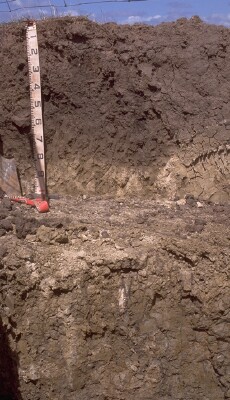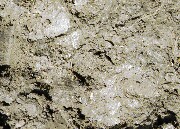SW86
Location: Winchelsea
Australian Soil Classification: Vertic (& Calcic), Mottled-Mesonatric, Black SODOSOL
General Landscape Description: Gently undulating plain.
Site Description: Depression, flat.
Geology: Quaternary basalt - Newer Volcanics
Vegetation: Sea Barley grass and thistles.
Soil Profile Morphology:
Surface Soil
| Ap | 0-8 cm | Very dark brown (10YR2/2 moist), greyish brown (10YR5/2 dry); cracking and hard setting surface condition; sandy clay loam; rusty root channel mottling prominent; strong consistence dry; few fine magnetic buckshot; pH 6.2; clear change to: |  SW86 Profile |
| A2 | 8-17 cm | Very dark greyish brown (10YR3/2 moist and 10YR5/1 dry); sandy clay loam; rusty mottling prominent; strong consistence dry; few fine magnetic buckshot; pH 6.9; abrupt change to: | |
| Subsoil | |||
| B21tg | 17-40 cm | Very dark greyish brown (10YR3/2 moist) with olive grey (5Y5/2 moist) mottles in ped interiors, and prominent yellowish brown (10YR5/8 moist) mottles associated with root channels; light medium clay to medium clay; many (~25%) roughly coarse prismatic, parting to coarse blocky and angular structure; mostly rough faced peds; very strong consistence dry; pH 8.1; clear change to: | |
| B22ss | 40-60 cm | Very dark greyish brown (2.5Y3/2 moist); weak fine lenticular and polyhedral structure; moderate slickensides; pH 8.6; clear change to: | |
| B23 | 60-80 cm | Dark grayish brown (2.5Y4/2); light medium clay; apedal; pH 8.8: | |
| B24kg | 80-200 cm | Olive to light olive grey (5Y6/2-5/3 moist); fine brownish yellow (10YR6/8 moist) mottles; soft, yellowish white carbonate; pH 9.2. NOTE: Calcareous clay continues to 2 metres depth. |

Slickensides in B22ss horizon (40-60 cm)
Key Profile Features:
- Strong texture contrast between surface (A) horizons and subsoil (B21) horizon.
- Heavy prismatic subsoil structures.
Soil Profile Characteristics:
pH | Salinity Rating | |||
Surface (A1 horizon) | Slightly Acid | Low | Non-Sodic | None1 |
Subsoil (B21 horizon) | Moderately Alkaline | Medium - High | Strongly Sodic | Strong |
Deeper Subsoil (at 90-100 cm) | Very Strongly Alkaline | High-Very High | Strongly Sodic | None2 |
| 1 Moderate dispersion after remoulding. 2. No aggregate dispersion due to very high salinity rating. Moderate dispersion after remoulding. | ||||

| The surface soil is slightly acid. The subsoil is moderately alkaline becoming very strongly alkaline with depth. | Salinity rating is low in the surface becoming medium in the subsoil and very high with depth. |
| The clay content increases markedly at the A/B boundary. |
Horizon | Sample Depth (cm) | pH (water) | pH (CaCl2) | EC 1:5 | NaCl % | Exchangeable Cations | |||
Ca | Mg | K | Na | ||||||
meq/100g | |||||||||
A1 | 0-8 | 6.2 | 5.7 | 0.24 | 7.3 | 8.9 | 0.72 | 1.4 | |
A2 | 8-17 | 6.9 | 6.2 | 0.15 | 4 | 5.2 | 0.2 | 1 | |
B21 | 25-40 | 8.1 | 7.3 | 0.6 | 0.11 | 4.4 | 12 | 0.7 | 3.8 |
B22 | 45-60 | 8.6 | 8.1 | 1.6 | 0.4 | 5.1 | 18 | 0.8 | 7.5 |
B23 | 60-80 | 8.8 | 8.5 | 2 | 0.46 | 5 | 19 | 0.7 | 8.1 |
B24kg | 90-100 | 9.2 | 8.6 | 1.3 | 0.25 | ||||
Horizon | Sample Depth (cm) | Exchangeable Aluminium mg/kg | Exchangeable Acidity meq/100g | Organic Carbon % | Nitrogen % | Field Capacity pF2.5 | Wilting Point pF4.2 | Coarse Sand (0.2- 2.0 mm) | Fine Sand (0.02- 0.2 mm) | Silt (0.002- 0.02 mm) | Clay (<0.002 mm) |
A1 | 0-8 | <10 | 12 | 7.2 | 0.27 | 35 | 17.9 | 20 | 31 | 14 | 28 |
A2 | 8-17 | 5.5 | 22.2 | 8.9 | 26 | 40 | 15 | 18 | |||
B21 | 25-40 | 38.7 | 18.2 | 15 | 32 | 13 | 37 | ||||
B22 | 45-60 | 46.6 | 24.9 | 12 | 24 | 13 | 48 | ||||
B23 | 60-80 | ||||||||||
B24kg | 90-100 |
Management Considerations:
Subsoil (B) Horizons
- The dense and coarsely structured subsoil is sodic and disperses completely. This will result in significantly restricted root and water movement into the subsoil.
- The subsoil displays vertic features (i.e. slickensides) which indicates that significant shrinking and swelling occurs during wetting and drying cycles. This may have engineering implications and is likely to explain the variability in surface horizon depth across the trench.
- The subsoil has a high level of soluble salts, which will restrict the growth of salt-sensitive species.
Notes
- To the west rising out of the depression more rock is present but soil deeper than west of SW87.
Profile Described By: Richard McEwan (March 1999).


